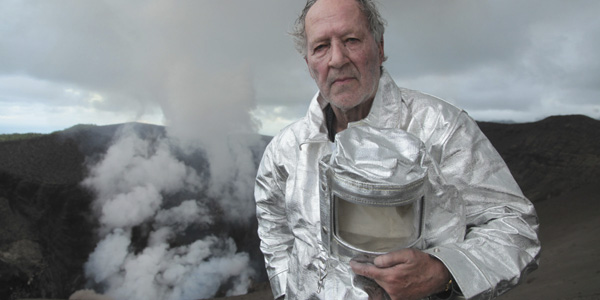![]() One of the wonders of Werner Herzog’s nonfiction films (such as Grizzly Man) is the revelation of places and sights that most of us have never seen. It’s as though he’s saying, “Come and look at this wondrous, potentially horrible sight before you.”
One of the wonders of Werner Herzog’s nonfiction films (such as Grizzly Man) is the revelation of places and sights that most of us have never seen. It’s as though he’s saying, “Come and look at this wondrous, potentially horrible sight before you.”
The overriding theme of Into the Inferno is captivating: how nations all over the world pay heed and the highest respect to volcanoes, and more: that there’s a spiritual connection between populations and the boiling lava and eruptions.
Herzog starts out in the Vanuatu archipelago in the South Pacific with British volcanologist Clive Oppenheimer, who Herzog met a decade ago while shooting in the Antarctica for Encounters at the End of the World). Their journey takes them to Ethiopia (called here the hottest place on Earth), Indonesia (where a chicken-shaped church is created in some kind of honor to volcanoes), and, most notably, North Korea. The film is a travelogue of sorts, but it doesn’t feel that way. Herzog spends enough time in each setting that viewers get their footing.
In Vanuatu, children make animalistic faces and gestures to the camera (a truly Herzogian moment), and one man tells an anecdote about how he went into a volcano to talk to its spirit (alas, we won’t know what was said—it was between him and the volcano). In Iceland, the Codex Regius, an epic, semi-religious text written centuries ago, recounts the power and ferocity of a 10th-century eruption.
North Korea is known as a nation that has, rather notoriously, cut off all contact with the rest of the world. There’s no Internet and no outside news, other than what the government tells the population. Massive public rituals of crowds, scarily on cue, make visual formations with colored cards that sometimes seem like we’re looking at CGI effects instead of human beings in action. It’s also uncanny and eerie how many paintings of the country’s presidents have the volcano Mount Paektu as a backdrop. Herzog knows he doesn’t need to say much here. The images of North Koreans—how they live, how the children sing in unison—say it all.
However, North Koreans do have a connection to others in the world, if only in that they have the similar respect and fear, bordering on admiration, for a force that cannot be controlled. In the Ethiopian desert, a team searches for remains and artifacts of our ancestors, going back tens of thousands of years. This section is the most entertaining and engaging. Tim D. White, an energetic paleoanthropologist from California, compares looking through dirt to gambling: Who will win today, you or the “house” that is the desert?
Sprinkled throughout are shots where Herzog and his cinematographer, Peter Zeitlinger, use a drone to capture footage inside volcanoes. It’s easy to see these as purely cinematic images of the roiling red and black lava crashing like waves (a comparison made more than once, and rightly so), or like science fiction sequences, as in 2001: A Space Odyssey. Even the music choices remind one of those haunted and awe-inspired choral chants in that film. Herzog narrates, and sometimes he has his subjects look into the camera head-on as in his other eccentrically shot films, though this one (like his other documentary this year, Lo and Behold, Reveries of the Connected World) is a bit more conventional than some of his others.
What is so strong about Into the Inferno, why it matters past being another Herzog daredevil excursion is that it’s about us, about the human experience and how communities come together and find common ground. (Ironically, in 1976’s La Soufrière, the director wanted to film an active volcano in the Caribbean, but the film became about how this eruption was not to be). Moreover, it suggests that if one lives in awe or respectful of the mystery of nature, it leads to a richer life.
In other words, come for the gorgeous cinematography, stay for theological existentialism!

















Leave A Comment